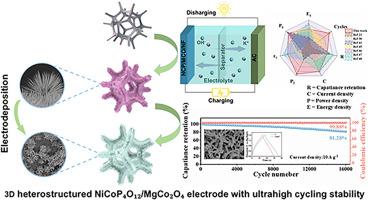Electrodeposition-constructed 3D interconnected NiCoP4O12/MgCo2O4 conductive network for high-performance supercapacitors
IF 4.7
3区 材料科学
Q2 MATERIALS SCIENCE, MULTIDISCIPLINARY
引用次数: 0
Abstract
Nickel-cobalt phosphate (NCP) readily suffers from severe nanoparticle agglomeration during synthesis, leading to non-uniform dispersion and degraded electrochemical performance; moreover, NCP generally exhibits poor cycling stability. To overcome these limitations, we designed a self-supported three-dimensional (3D) heterostructured electrode of NiCoP4O12/MgCo2O4 (NCP/MCO) on Ni foam (NF). One-dimensional MCO nanowire arrays were first grown in situ as a robust, high-surface-area scaffold, followed by the uniform electrodeposition of zero-dimensional NCP nanoparticles to form a tightly integrated 3D network. The 3D network structure provides continuous electron-transport pathways, while the intimate contact at the NCP/MCO heterointerface further reduces charge-transfer resistance and facilitates ion diffusion, synergistically accelerating Faradaic kinetics and enhancing durability. This hierarchical architecture suppresses particle aggregation, shortens ion/electron diffusion paths, and improves structural integrity and charge-transport efficiency. As a result, the NCP/MCO/NF electrode delivers a high specific capacity of 273.74 mAh g−1 at 1 A g−1 and 210.5 mAh g−1 at 20 A g−1, while retaining 88.29 % of its capacity after 8000 cycles. The assembled NCP/MCO/NF//AC hybrid supercapacitor achieves an energy density of 51.46 Wh kg−1 at a power density of 800 W kg−1 and maintains 81.28 % of its initial capacity after 16,000 cycles. This work highlights a practical strategy for engineering interfacial contact and 3D architectures to realize high-rate, long-life supercapacitors.

电沉积构建的高性能超级电容器用三维互联NiCoP4O12/MgCo2O4导电网络
磷酸镍钴(NCP)在合成过程中容易发生严重的纳米颗粒团聚,导致分散不均匀,电化学性能下降;此外,NCP通常表现出较差的循环稳定性。为了克服这些限制,我们在Ni泡沫(NF)上设计了NiCoP4O12/MgCo2O4 (NCP/MCO)的自支撑三维(3D)异质结构电极。一维MCO纳米线阵列首先在原位生长,作为坚固的高表面积支架,然后均匀电沉积零维NCP纳米颗粒,形成紧密集成的3D网络。三维网络结构提供了连续的电子传递途径,而NCP/MCO异质界面的密切接触进一步降低了电荷转移阻力,促进了离子扩散,协同加速了法拉第动力学,提高了耐久性。这种分层结构抑制了粒子聚集,缩短了离子/电子扩散路径,提高了结构完整性和电荷传输效率。结果表明,NCP/MCO/NF电极在1 a g−1和20 a g−1条件下具有273.74 mAh g−1和210.5 mAh g−1的高比容量,在8000次循环后仍能保持88.29%的容量。组装的NCP/MCO/NF/ AC混合超级电容器在800w kg - 1的功率密度下,能量密度达到51.46 Wh kg - 1,循环16000次后保持81.28%的初始容量。这项工作强调了工程界面接触和3D结构的实用策略,以实现高速率,长寿命的超级电容器。
本文章由计算机程序翻译,如有差异,请以英文原文为准。
求助全文
约1分钟内获得全文
求助全文
来源期刊

Materials Chemistry and Physics
工程技术-材料科学:综合
CiteScore
8.70
自引率
4.30%
发文量
1515
审稿时长
69 days
期刊介绍:
Materials Chemistry and Physics is devoted to short communications, full-length research papers and feature articles on interrelationships among structure, properties, processing and performance of materials. The Editors welcome manuscripts on thin films, surface and interface science, materials degradation and reliability, metallurgy, semiconductors and optoelectronic materials, fine ceramics, magnetics, superconductors, specialty polymers, nano-materials and composite materials.
 求助内容:
求助内容: 应助结果提醒方式:
应助结果提醒方式:


